There’s nothing like the satisfaction of growing your pepper plant and reaping the rewards of homegrown produce. However, at some point in the growth of the peppers, you will see yellowing leaves on pepper plants. So, the most common question is: Why are my pepper plant leaves turning yellow? In this article, I will help you to find out how to fix yellowing leaves on pepper plants.
In this article, we delve into the puzzling phenomenon of pepper plant leaves turning yellow, exploring the potential causes and offering practical solutions to nurse your plants back to health. Whether you’re an experienced gardener or a novice green thumb, understanding the reasons behind yellowing leaves is crucial for maintaining a thriving pepper garden.
Table of Contents
Why Are My Pepper Plant Leaves Turning Yellow
You are probably wondering why are my pepper plant leaves turning yellow? There are several causes why the leaves of the peppers plant turn yellow. Fortunately, all these causes can be treated so the peppers plant recovers. The reasons for yellowing leaves on peppers plants are as follows:
- Nutrient Deficiencies
- Watering Stress
- Pests
- Diseases
- Chlorine
- Cold Weather
Fortunately, almost all these things that cause yellow leaves on pepper plants are treatable and can save your pepper plant.
Continue reading to learn all about yellowing leaves on pepper plants.
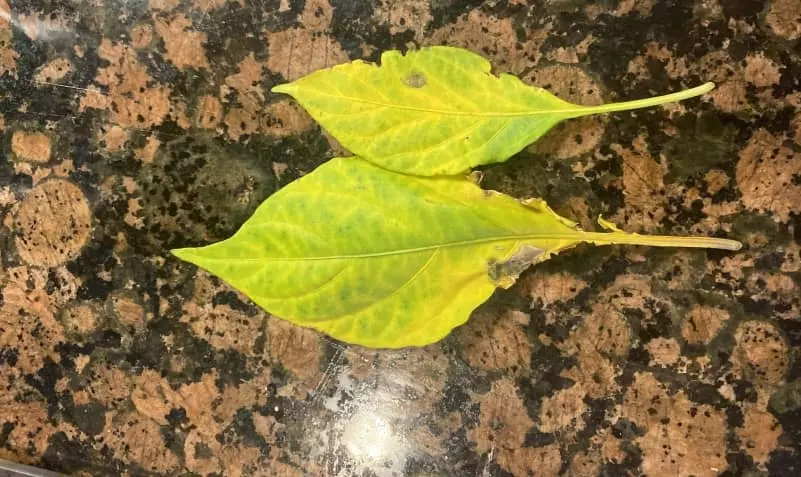
Pepper Plant Leaves Turning Yellow Due to Nutrient Deficiencies
Nutritional deficiency is one of the most common causes of pepper plant leaves turning yellow. To develop properly, pepper plants need nitrogen, phosphorus, and magnesium, among other minerals. An article from the University of Minnesota states that the ideal soil pH for peppers is between 6.5 and 7. An optimum soil pH will allow the pepper plant to properly absorb nutrients from the soil.
Before fertilizing the pepper plant, it is best to measure soil pH to ensure that the peppers have the correct pH values to properly absorb all the nutrients and make the best use of the fertilizer. The University of Michigan recommends using NPK 5-10-10-10 or 8-16-16 fertilizers for peppers.
So, if you are wondering why are my pepper plant leaves turning yellow? The most likely answer is that your pepper plants have yellow leaves due to nutritional deficiency. Once you start fertilizing, you will see your pepper plant improve. The yellowing leaves will stay yellow, but the new leaves will not suffer from this nutrient deficiency problem.
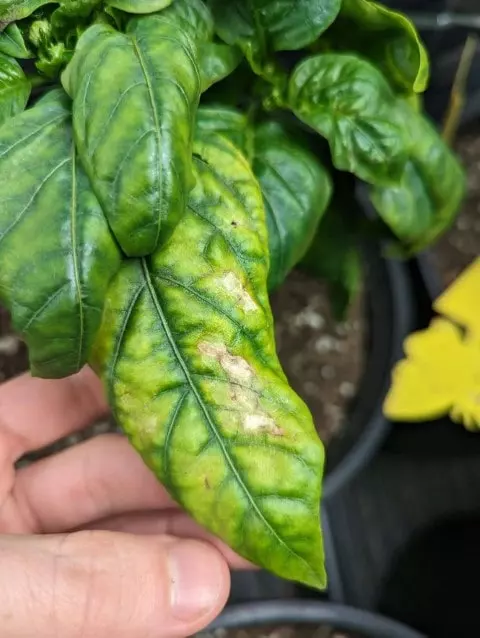
- Nutrient-Rich Formula: Our fertilizer is specially crafted with essential nutrients to nourish tomato plants and vegetables, promoting robust growth and abundant yields.
- Versatile Plant Food: Ideal for all types of plants and vegetables, our fertilizer supports the overall health and vitality of your garden, ensuring optimal growth.
- Tomato-Boosting Power: Specifically formulated for tomatoes, our fertilizer enhances fruit development, resulting in juicy, flavorful tomatoes bursting with natural goodness.
Pepper Plant Leaves Turning Yellow Due to Watering Stress
Water stress is another of the most common problems that cause yellow leaves on peppers plants. Overwatering or underwatering causes stress to peppers plants. Peppers need to have a moist substrate, but not waterlogged, a good way to conserve moisture is to mulch the substrate.
If you are growing peppers in pots, ensure that the pot has sufficient drainage holes and that the substrate used is correct to promote good drainage and moisture retention. Normally a potting mix will be adequate. Poor pot drainage could lead to root rot, which is the last thing you want to happen.
After watering, lift the pot to feel the weight, and you will know how heavy the pot is after watering. The next day lift the pot again to feel the difference in weight. This way, you will learn how fast the substrate dries after watering.
Another way to know if the substrate’s moisture is correct for peppers plants is to use a 3 in 1 meter that measures pH, moisture, and light. These devices are very inexpensive and do not require batteries to operate. By doing so, you can easily check the moisture content of the substrate.
So, if you are wondering why are my pepper plant leaves turning yellow? Overwatering or underwatering also causes yellowing leaves on peppers plants. Periodically check the substrate to ensure it is at the right moisture level for your pepper plants.
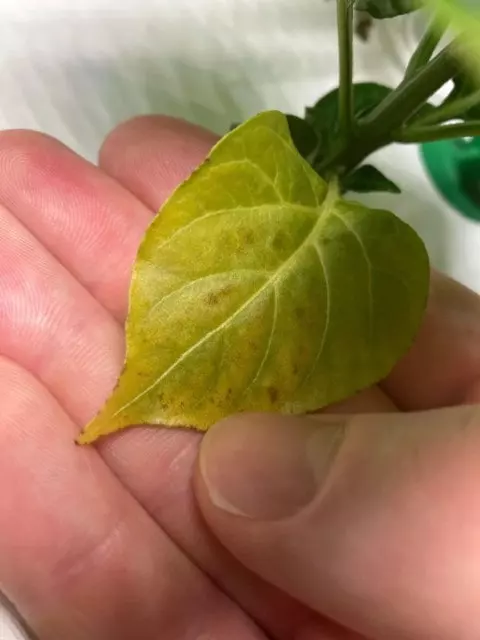
Yellowing Leaves On Pepper Plants Due to Pests
As mentioned above, the most common causes of yellow leaves on pepper plants are nutritional deficiency and water stress. Still, there are also causes, such as pests. Some pests, such as aphids, affect pepper plants and cause yellow leaves. These are some of the pests that attack peppers plants and cause yellowing leaves:
- Aphids
- Mites
- Psyllids
- Flea beetles
- Whiteflies
Fortunately, several methods exist to keep these pests away from peppers without using chemical pesticides. For example, ladybugs feed on aphids, and a single ladybug can consume many aphids daily. You can go to a park and collect ladybugs to release on your peppers plants. You can also get ladybugs for your garden from online stores. I recommend you read our article: Are ladybugs good for the garden?
You can also use diatomaceous earth to treat pests that attack your peppers and cause yellow leaves. Diatomaceous earth acts by contact with the insects and kills them. However, do not release ladybugs and apply diatomaceous earth because it will kill them, just use one of the two methods on your peppers with yellow leaves. Learn more about how to use diatomaceous earth in potted plants.
Neem oil is very good at eliminating most of the pests mentioned above that affect pepper plants and cause yellow leaves. Use neem oil, and the pests should disappear from your peppers in a few days. Never apply neem oil in the morning because the oil will heat up with the sun’s heat and could cause sunburn on the leaves. I recommend you read our article on how to mix neem oil for plants.
Pepper Plant Leaves Turning Yellow Due to Diseases
You looked at your pepper plants and observed no nutritional deficiencies, no water stress, and no pests, so why are your pepper plant leaves turning yellow?
Another possible cause of yellowing the leaves on pepper plants is diseases. Some of the most common diseases affecting peppers are the following:
- Phytophthora Blight
- Wilt
- Bacterial Leaf Spot
Suppose the leaves of your pepper plant are becoming yellow and developing brown spots. In that case, it typically indicates a bacterial leaf spot. As mentioned by West Virginia University, prevention is the best in these cases. For example, there are peppers resistant to bacterial leaf spot varieties such as Raven and F1 Autry.
Pepper plants can also undergo yellowing and leaf loss due to Phytophthora blight, a different disease. This condition is caused by the soilborne pathogen P. capsici, a fungus type. The most frequently observed symptoms in peppers affected by Phytophthora blight are crown and fruit rot. Normally, peppers affected by this disease die.
Pepper plants can be affected by Verticillium wilt, which is a fungal disease. This condition is caused by Verticillium dahliae, a soilborne fungus that targets the plant’s vascular tissues.
Symptoms of Verticillium wilt include the yellowing and drooping of leaves. Infested leaves tend to curl inward, and foliar wilting becomes apparent. In severe cases, the leaves of affected plants turn brown and become dry and brittle. As the disease advances, the entire plant will eventually succumb and perish.
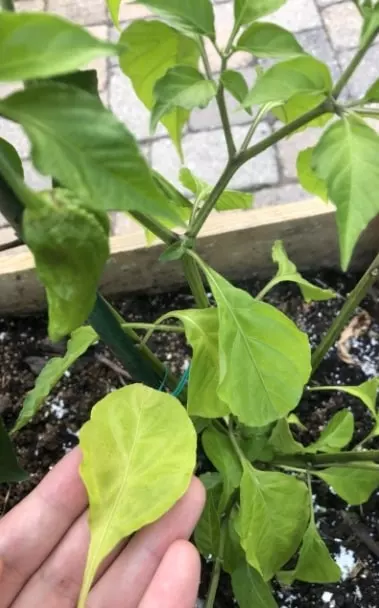
How To Fix Problems Due to Pepper Diseases
Prevention is the most effective remedy when it comes to addressing pepper diseases. Suppose you notice plants showing severe signs of disease, such as extensive wilting or damage. In that case, it’s best to remove them from your garden. This helps prevent the spread of the disease to other healthy plants.
Consider planting pepper varieties that are specifically bred to be resistant to common diseases in your area. These varieties are less likely to be affected or suffer severe damage.
Keep your garden clean by regularly removing plant debris, fallen leaves, and fruits. This reduces the potential for disease-causing pathogens to overwinter and re-infect your plants.
Remember, prevention is often the best approach to managing plant diseases. By implementing good gardening practices and promptly addressing any signs of illness, you can help protect your pepper plants and maintain a healthy garden.
Pepper Plant Leaves Turning Yellow Due to Much Chlorine
If the water you use to water your peppers plants contains too much chlorine, this could be one of the causes of pepper plant leaves turning yellow. Leaving the water in containers for more than a day will allow the chlorine to evaporate, and you will be able to water your peppers.
You can collect rainwater to irrigate your peppers, and this will ensure that it is chlorine-free water. It is not common for pepper leaves to turn yellow due to excess chlorine, but it is possible. It should be considered when looking for causes.
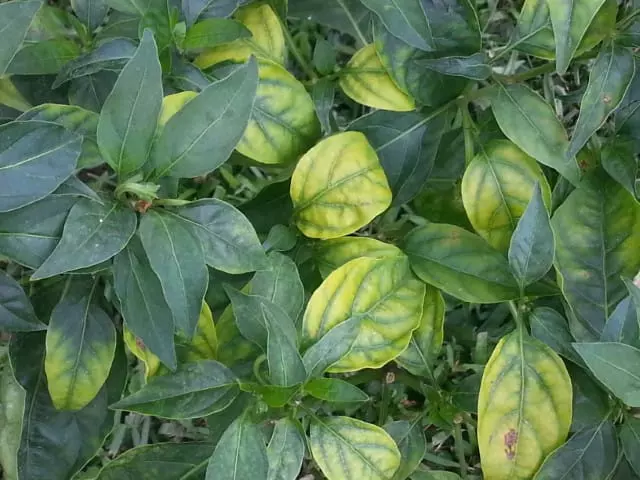
Pepper Plant Leaves Turning Yellow Due to Cold Weather
Pepper plants have a known aversion to temperatures below 60 °F (15 °C), and leaf loss can occur when temperatures drop to around 40 °F (5 °C). Extreme cold below 30 °F (-1 °C) can be fatal to these plants. Suppose the yellowing of leaves is observed throughout the plant. In that case, low temperatures are likely the underlying cause.
In the event of a sudden drop in temperature and the subsequent wilting or yellowing of your pepper plants, there are several measures you can take to aid in their recovery. Firstly, if feasible, consider relocating the plants to a warmer area. Additionally, suppose the cold weather is expected to persist. In that case, you can attempt to shield the plants by covering them with a tarp or blanket to provide insulation.
Final Conclusions
In conclusion, if you notice your pepper plant leaves turning yellow, there can be various causes, including nutrient deficiencies, water stress, disease, or cold weather. Proper diagnosis is essential to determine the specific issue at hand.
I trust that this information assists you in identifying the cause behind the yellowing of your pepper plants. Pepper plants possess various ways of indicating dissatisfaction, and the yellowing leaves are another indicator.
If you are passionate about peppers, I recommend you to read our articles about peppers:


